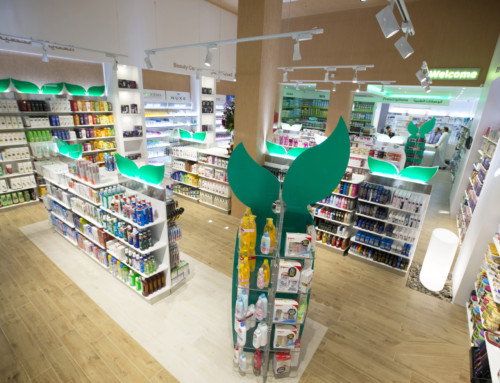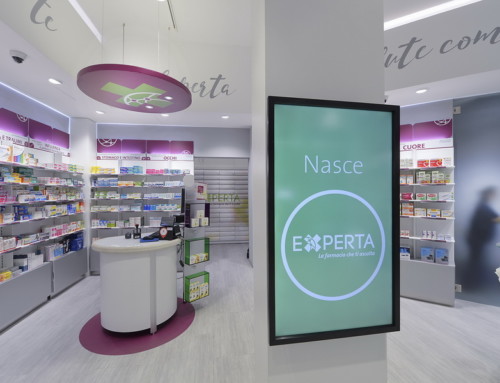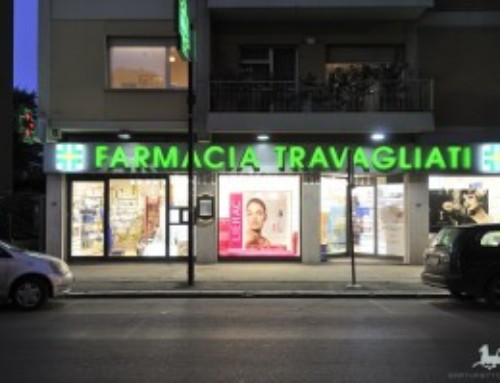Customer behaviour in the pharmacy
It will be ever-more necessary to take care of your customers if you want to face the competition and increase revenue from the commercial component of your activity.
**The client is the King!**
How many times have I heard this phrase? In almost all fields, except in the pharmacy.
Even today you can perceive a feeling of customers being subject to the pharmacist who is in essence a professional and at the same time, the institution of health that the customer trusts.
If this is (still) true, it is equally undeniable that something is changing in the relationship between customers, medicine and pharmacies.
The effects of review spending are visible to everyone and can be synthesized by pharmacies in a significant loss in profit for the component of prescription medicine in the same volume (units sold, prescriptions managed).
The consequence is that to maintain the same profitability profile, pharmacies facing a growing cost structure (think about lengthening opening hours and adding professional services), must simultaneously maintain the turnover level of prescription medicine and increase the commercial revenue component.
Achieving the first objective means defending the market share in your catchment area and possibly attracting new customers from inside and outside the area.
It’s a radical change, which is leading pharmacies away from being undifferentiated. It’s leading them away from being chosen based on proximity and leading them closer to seeking a distinctive position, and being chosen based on the superiority of what they have to offer (personnel, products and services).
Focusing on commercial turnover means competing with all the other channels, from chemist shops to supermarkets, through to every type of specialist (perfumeries, herbalists, spas, beauty salons, gyms, etc.). It means competing in areas where the pharmacist’s reputation, (without demeaning it in an way) is not necessarily the determining factor or the only choice the customer has.
On both counts, therefore, there has been an increase in competition, which shifts some power to the customer who is evolving with the environment, learning to use new offers and helping to change them.
![]() http://www.sartorettoverna.com/pharmacies-from-hell-to-bring-about-change.html
http://www.sartorettoverna.com/pharmacies-from-hell-to-bring-about-change.html
Analysis carried out on customer behavior found these types of changes:
Regarding internal competition, we are increasingly witnessing a reduction of loyal customers to a specific pharmacy in the same channel
However, with respect to the sales of commercial products (i.e gyzr2ba. customers who have not just bought their medicine during their visit to the pharmacy) customer loyalty has increased, and at the same time the demand for widening the product choice has increased: obvious signs that the pharmacy is entering into much clearer and open multi-channel competition. Competition in which the entrepreneur can and should use two fundamental tools for the retail specialist: the professional advice of the staff and space to display products.
If the importance of advice takes on a value substantially equivalent to the purchase of medicine for self-medication and parapharmaceutical products, the sales environment is extremely relevant also in the pharmacy (accounting for 38% of purchase decisions).
Pharmacies are learning to manage space and at the same time customers are learning, (fairly quickly, it’s up to you to educate them!) to feel comfortable in the pharmacy. A third of customers remember the communication materials that they saw in the pharmacy, and how the product is displayed increasingly influences their choice of brand both for self-medication, and for parapharmaceuticals.
Customers are increasingly more informed, and are certainly more aware of the value of their purchases. Value that isn’t represented only by the price or how close they are, but value that is more and more sought after in an active form of shopping: under the emotional profile and from the point of view of professional advice.
This evolving client is part of a context that raises the level of competitive challenge and requires pharmacies to find resources to invest in space management for self-service, in the presence of specialized personnel in areas dedicated to testing/analysis.
The findings of those who have made these investments, however, are encouraging: pharmacies that have invested in these three areas have achieved better performance than those who have maintained a more traditional approach.
The first group more than the second showed than in Europe, (among other indicators) there was: a higher influx of people (3 times a month against twice a month), a higher level of loyalty from customers from 5% to 10% and a 20 to 25% increase in how much customers spend in the pharmacy.
This creates a customer profile of that, while there may be other alternatives, a proven ability to assess, and a greater level of awareness caused by the circulation of information both about products and about where to buy them, on the other hand is also sensitive to the pharmacy’s proposals and in-store marketing.
Considering that medicine, personal hygiene and services are among the few that still continued to bring revenue in the period between 2007-2012 and that in all areas we are seeing a strong return to neighborhood trade at the expense of the hypermarket and large commercial organizations, the pharmacy is theoretically in a better position to be able to meet the demands of the client-king.
However, to do this the pharmacy must make some significant changes in the way it presents itself:
Increase its ability to read and analyse requests
Increase competition in its area
Invest in human resources (both in terms of expertise, and in terms of training and incentives to managing the customer relationship)
Learning to manage the retail space and store communication
In short, it must start doing professional marketing!
.. Making sure, in particular with regards to the last point, not to slip into offering models cloned from the mass market, because there is not the space to consent the kind of economy that large-scale retailers have and above all is not what the customer wants.
If ecology creates new jobs, globalization is a source of anxiety, the media is changing people’s behaviour and they are becoming more individualistic and need more guarantees, therefore the customer has changed a lot in recent years.
In the nineties the client was won over mainly by the price of the products offered. This explains the explosion of supermarkets, sales and promotions.
Even today price is very important, but there have been some changes:
The customer is no longer willing to buy products that cost little, but that do not respond exactly to their needs.
Advice in choosing the product has become as important as the price.
The request for assistance in purchasing leads to a growing demand of specialised distribution.
This is combined with a kind of narcissistic customer who wants to stand out from the crowd, affirming their individuality.
The customer wants to be recognised, respected; they want to buy a customised product. They tend to want to leave mass distribution behind and are looking for a one-to-one relationship. They want to take care of themselves and have become hedonistic.
Distribution is adapting. These trends are evident in perfumery, clothing, and footwear.
The customer is demanding, hedonistic and narcissistic and wants products that look alike.
What has happened in the last fifty years?
In the period between the Second World War and the mid-seventies, facing strong economic development the customer discovered consumerism.
In 1974 the first oil crisis occurs, but the customer continued to spend.
In 1983 unemployment exploded and people began to worry about job security. People began to save money and became afraid of the future.
In 1991 the Gulf War broke out and the consumer society was deeply transformed.
In 1998, with economic recovery, the customer began to consume with renewed dynamism, but this euphoria was short-lived.
In 2001 the economic crisis returned and unemployment rates started to rise again.
Social change leads to a new way of consuming.
The customer has the feeling of being cheated by large companies, by an artificial price, from bogus innovations, from forced sales, from misleading advertising.
They develop therefore, a critical sense and demand more and more guarantee from the products that are offered. They want warranties and safety.
A study conducted in France in 1999 shows that 64% of customers do not trust hypermarkets and supermarkets. The great love is over. They continue to purchase there, but with reservations.
Social changes determine new ways of consuming:
The lengthening of life expectancy is reflected in individual and in collective life
Health has become a source of concern throughout society. The pursuit of health and harmony is a core value in our personal and professional lives: you must have an iron constitution to meet the needs of modern life
Insecurity comes in many forms: health-food (mad cow disease, dioxin chickens, genetically modified substances), staff (crime, wars etc.)
Impotence at a political-institutional level (financial scandals, mergers and acquisitions, mass unemployment) means a loss of employee confidence in company executives. This growing insecurity has a direct consequence on the customer, who has become a stressed and fearful individual, and wants to be reassured
Information and communication increase people’s insecurities. The media, in search of scoops, exaggerate and increase stress and fear. The Internet has changed the way we consume, it is the instrument of a new civilization in culture, advertising and particularly in trade. E-commerce growth rates are huge. E-commerce and mail order sales represent an indirect competitor for pharmacies. People usually buy small orthopedics, pressure gauges, rings and patches, OTC medicines and parapharmaceutical products. This trade has increased dramatically. The Internet is a worldwide connection. You can buy a product in any country, in Belgium, in Switzerland, in Germany, in the United States. You can buy medicine which is prohibited where you live. Since there is no law at distribution level, these substances, including household medicines, can be sold without obstacles.
We need to reflect and find an answer. Competition forces you to do better.
Free time has taken on a more important role than working life and has been ladened with anxiety and stress.
There are images of pain on television every day. In the past people were aware of disasters or calamities that struck the region they live in. Today, on the news people hear about disasters that occur on the entire planet in real time, which has changed the morale of citizens and is reflected in customer behaviour.
The client tries to forget. Observers say: “You exit the consumer society to enter the society of consolation”. You buy to forget.
The percentage growth of the senior population causes a steady increase in demand for goods and services. This part of the population is becoming increasingly important and represents 50% of customers for businesses operating in the leisure and entertainment industry.
The purchasing power of seniors is far greater than in the sixties, as is their determination to consume compared to forty years ago. Nowadays, they are people full of life, who are not cooped up at home. They travel, dress well, and want to stay young and therefore spend.
In the United States it has already been clear for fifteen years that this sector of the population could have been turned into a gold mine.
Smart businessmen have installed a sign that caters to presbyopia in their stores, typical of people of elderly people. Why have you not done this yet?
This part of the population is linked to the values of tradition, safety, guarantees, and has a very important characteristic: they become loyal, when they find someone who responds to their expectations in terms of honesty, guarantees and good advice.
The elderly, as opposed to young people, do not like going from one shop to the other.
How to respond to client expectations
In France, non-reimbursable medicine purchases accounted for 1.5% of household expenditure in the seventies, whilst in 2000 it rose to 2.8%.
According to a study carried out in the seventies, the vast majority of the French attributed the responsibility for their health to doctors and medicine.
A survey conducted between 1995 and 1998, states that for 72% of the French population, health depended primarily on their direct and personal attention to the problem.
Information spread by the world of medicine has created a new awareness among the population. The customer knows who is responsible for their condition.
This has also changed the way we see the pharmacy. Yesterday it was considered a place where sick people would congregate; you would go there with a prescription and only buy the medicine.
The pharmacy today is a place where healthy people go, that want to stay healthy.
The pharmacist has become the person who helps to prevent illness and eliminate the need for intervention from the doctor.
The birth of this new figure of the pharmacist is also linked to the increasing importance of health costs. The Public Health Service cuts costs and increases the amount of money that the customer has to spend. It has caused health care at to go at two speeds: one for those who can afford insurance and another for the poor.
The pharmacist must be able to face this situation, being available when the customer needs them.
Eating organic food has grown by 30%, compared with a 4% increase in the conventional agro-industry. The organic market only holds a small percentage of the overall food market, but insecurity and fear spread among customers has pushed them to buy organic products, even when prices are far higher than those of non-organic products. Organic is a market overdrive.
The customer asks for manufactured and tested natural skin cosmetics. During a recent survey, the question “what products do you put on your face and on your skin?”, 78% of the women asked answered “natural products. Plant-based products, and checked by the dermatologist. ”
We don’t need to skimp on the explanations. Customers get information from the web, television, magazines, information which is often partial and incomplete.
The customer wants to be helped when choosing. They need precise information. Customers in general, do not consider the information contained in leaflets as useful, they are not clear and use terms that are difficult to understand. Customers prefer direct explanations provided by the pharmacist, who is obliged to not to disappoint them in order to remain a point of reference and therefore must specialise more.
50% of the French population are convinced that they are misinformed. A response to this is to provide clear and simple communication in the shop windows, products, documentation, signage, and promotion but especially in the language which needs to be easy to understand.
If you understand that security is a priority you will therefore propose authentic, natural, biological, and ecological products.
It demands a greater competence on the part of the distributor. It ‘s the “sine qua non” to innovate in a proper manner, to understand customer’s needs and bring solutions in terms of products and services, to get in touch with the customer at almost an individual level.
A NEW CONSUMPTION MODEL
A turnaround in the trend has been identified, a negative spiral for hypermarkets and supermarkets who occupy large spaces, thus benefitting businesses who occupy small spaces marking a return to a more human scale.
The customer demands tailored-made products and services, intimacy in the commercial relationship, personalised care, one-to-one marketing.
You can no longer ask the customer to queue, to wait his turn and then serve him briskly: this type of relationship between customer and pharmacist is over.
The pharmacy is at the centre of this kind of problem. Typically, it is a small area where it would be enough to review the layout and adapt to customer needs.
The elderly are the new Eldorado. If you forget them, you will sacrifice 20-30% of your turnover. In beauty and skin cosmetics, 48.5% of products for body care is purchased by senior customers, who need to be provided with comfort, convenience, friendliness etc.
The quality / price ratio has been replaced by the value / cost ratio
In other words, we must justify the price of a product in relation to the benefits it brings. The customer does not look first and foremost at the price, but instead the results that the product guarantees; they do not want to spend little if it’s not worth it. The customer wants to be able to defend the expense on the basis of the benefits that it brings them.
If the consumer society is becoming more and more a society of consolation, you will need to invigorate the company, make daily life more exciting. The pharmacy must cease to be a sad place, painted with serious colours, whose rooms and facilities are always so similar to each other. You have to add dynamics.
If your pharmacy does not present anything new, the attitude of the customer will remain the same: come in, buy, and leave. It’s important to liven up the pharmacy.
Ecological expectations have become increasingly pressing: respect for nature and the environment, organic products and, again, the humanitarian side. In sales, the humanitarian message has an increasingly effective value. It is no coincidence that many brands reserve a percentage of the price to humanitarian actions. The customer buys willingly, saying to himself: “I’m buying and consuming but I’m also doing a good deed”.
Another opening to new and old customers is represented by testing and prevention, which is still largely underdeveloped.
The customer doesn’t want to talk about his health in the pharmacy
If you want to build a sustainable business you have to find ways of providing specialised information to help customers cope with their problems.
Let the new pharmacy begin!
![]() http://www.sartorettoverna.com/pharmacies-from-hell-to-bring-about-change.html
http://www.sartorettoverna.com/pharmacies-from-hell-to-bring-about-change.html







Leave A Comment